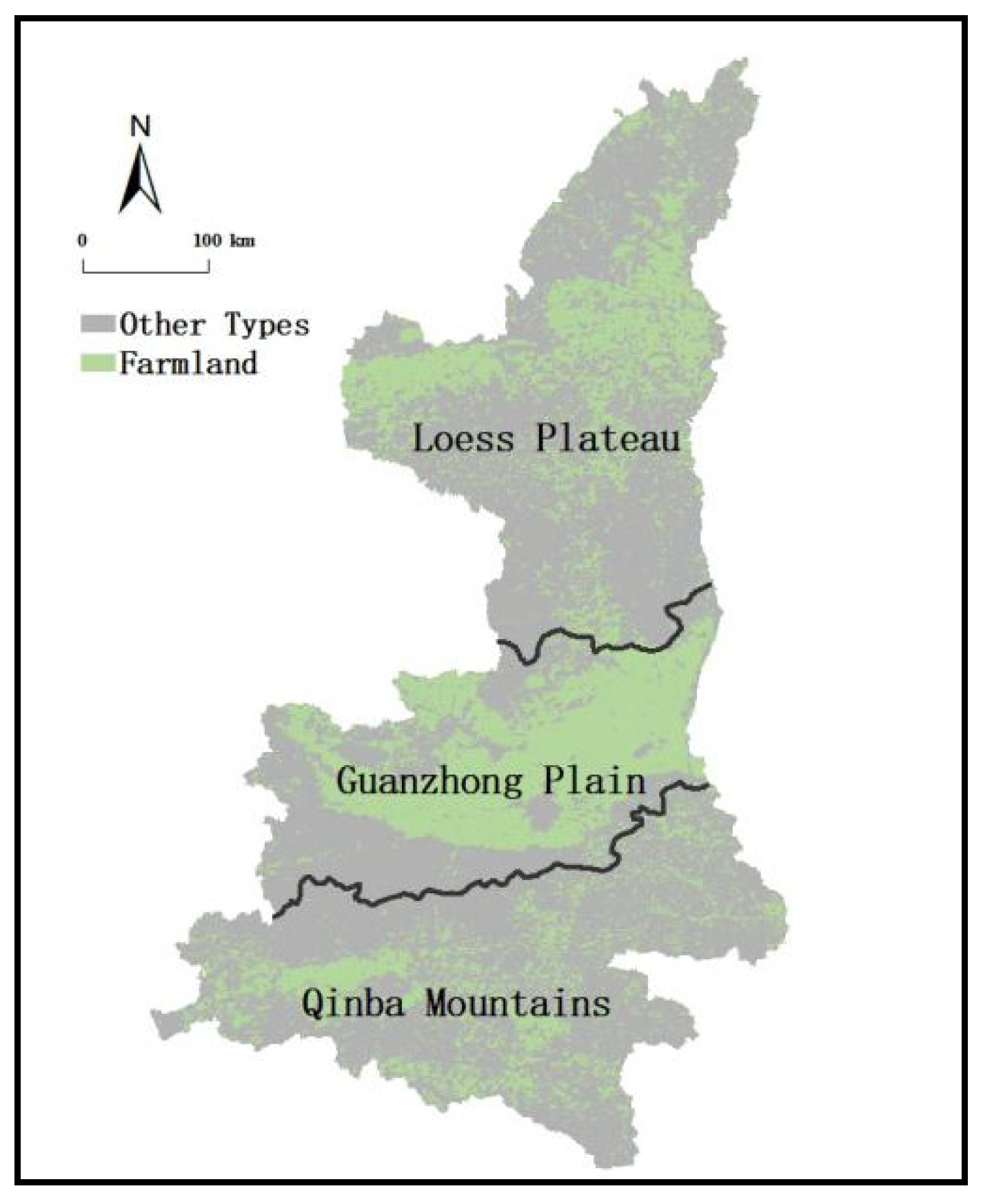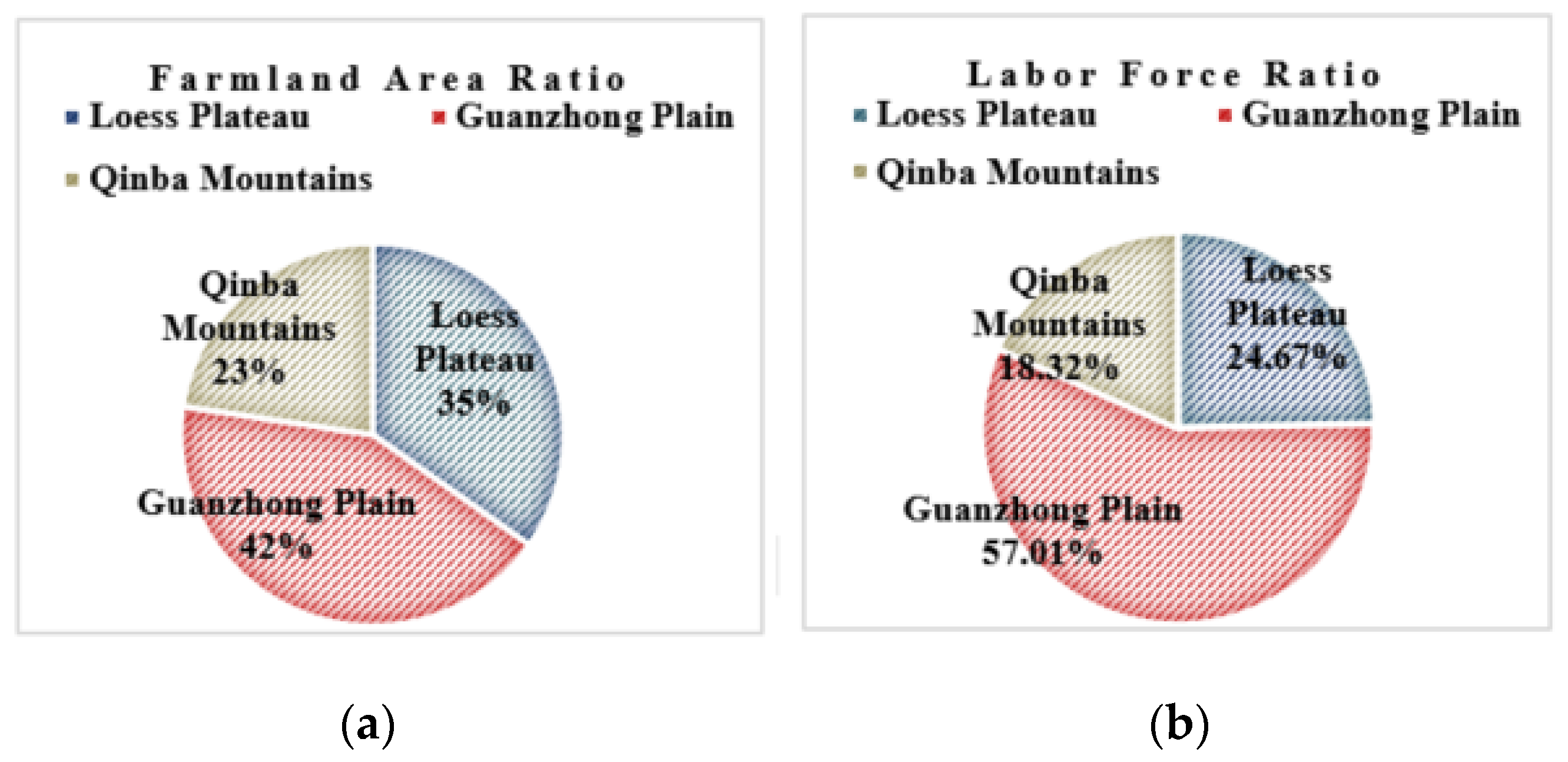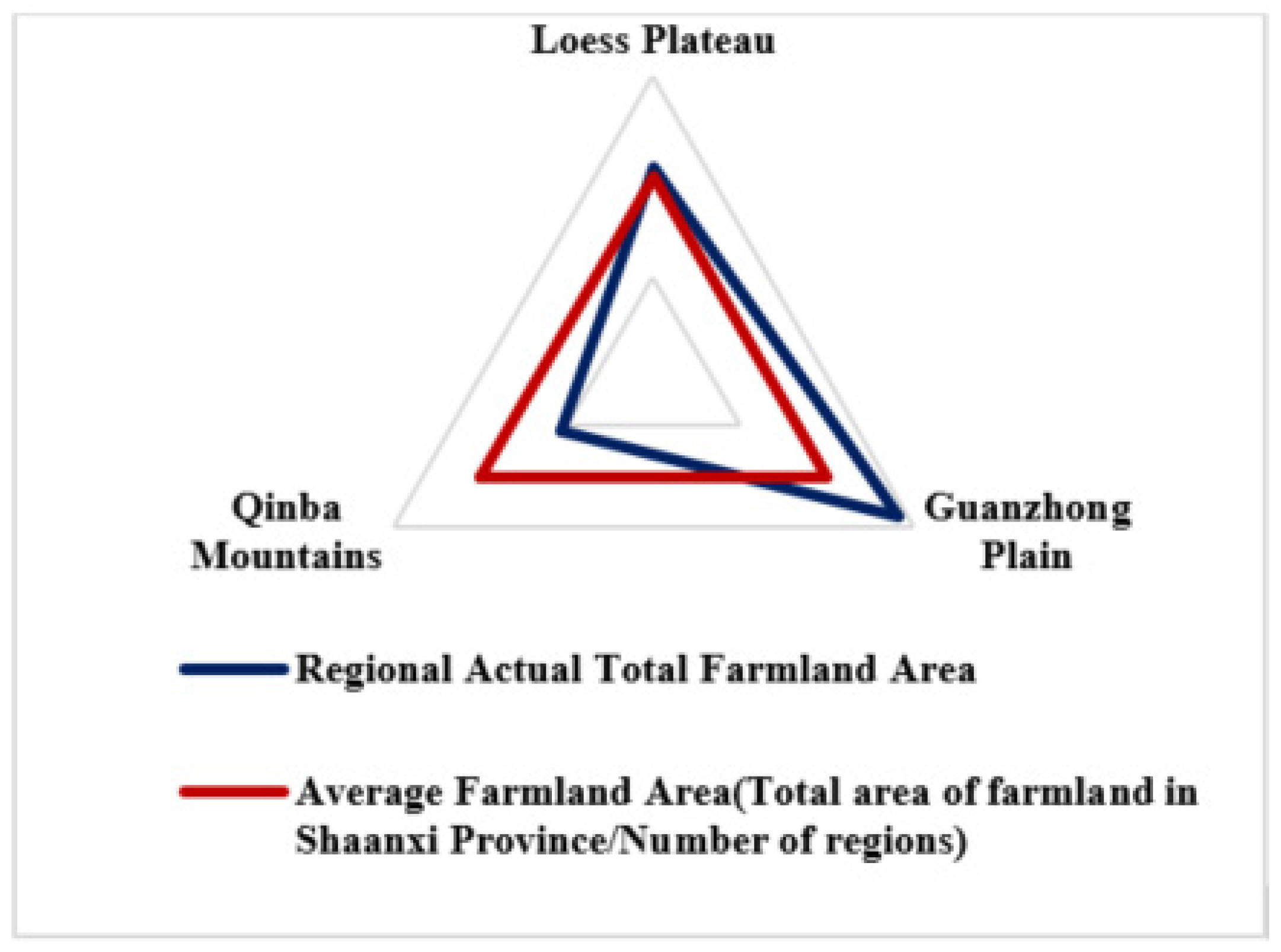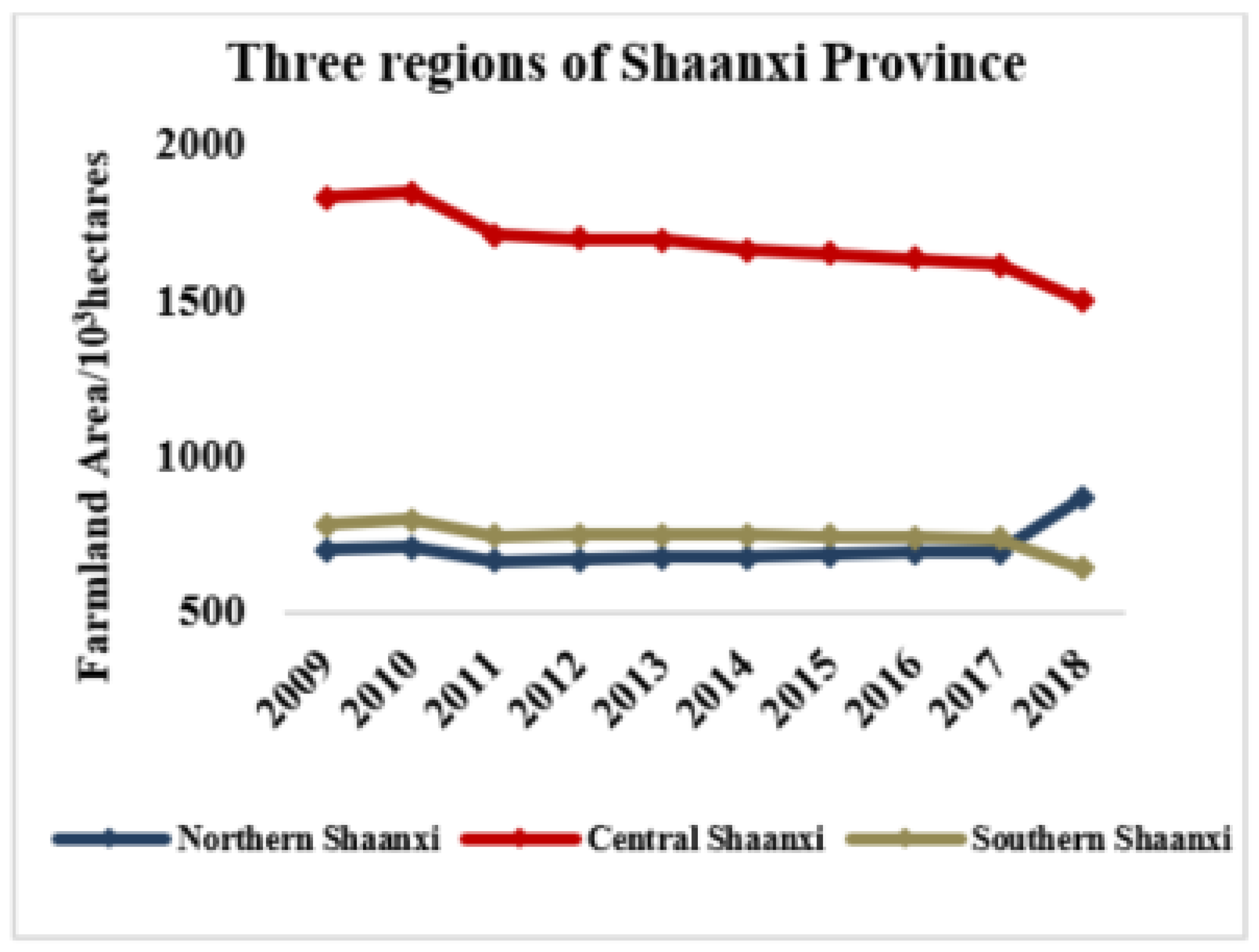Appropriate Management Scale of Farmland and Regional Differences under Different Objectives in Shaanxi Province, China
Abstract
1. Introduction
2. Materials and Methods
2.1. Overview of the Study Area
2.2. Data Sources
2.3. Research Methods
2.3.1. Appropriate Management Scale under the Goal of Maximizing Farmland Production Calculation
2.3.2. Appropriate Management Scale under the Goal of Maximizing Farmers’ Profit Calculation
3. Results
3.1. The Appropriate Management Scale of Farmland in Shaanxi Province
3.2. The Appropriate Management Scale of Farmland in the Three Regions
4. Discussion
4.1. Regional Differences of the Appropriate Management Scale under the Goal of Maximizing the Farmland Production
4.2. Regional Differences of the Appropriate Management Scale under the Goal of Maximizing Farmers’ Profit
4.3. Implication, Application and Limitation
5. Conclusions
Author Contributions
Funding
Institutional Review Board Statement
Informed Consent Statement
Data Availability Statement
Acknowledgments
Conflicts of Interest
References
- Carter, C.A.; Chen, J.; Chu, B. Agricultural productivity growth in China: Farm level versus aggregate measurement. China Econ. Rev. 2003, 14, 53–71. [Google Scholar] [CrossRef]
- Wu, B. An Empirical Analysis of the Impact of farmland Scale on Agricultural productivity in China—Based on 2002–2016 panel data. In Proceedings of the 2018 8th International Conference on Education, Management, Computer and Society (EMCS 2018), Shenyang, China, 2 November 2018; Francis Academic Press: Abingdon, UK, 2018. [Google Scholar]
- Supawat, R.; Zhang, Y. Examining the economic performance of Chinese farms: A dynamic efficiency and adjustment cost approach. Econ. Anal. Policy 2018, 57, 74–87. [Google Scholar]
- Jiao, B. The trend and enlightenment of large-scale farmland management in Japan. Fudan J. Soc. Sci. Ed. 2000, 396, 103–109. [Google Scholar]
- Sanzidur, R.; Mizanur, R. Impact of land fragmentation and resource ownership on productivity and efficiency: The case of rice producers in Bangladesh. Land Use Policy. 2008, 26, 95–103. [Google Scholar]
- Luo, Q. The Influencing Factors of the Moderate Scale Operation of Agriculture—On how to achieve the optimal scale of land operation in China. Econ. Res. Guide 2008, 4, 12–13. [Google Scholar]
- Zheng, S. Research on the appropriate scale of land management. Issues Agric. Econ. 1998, 19, 3–5. [Google Scholar]
- Chen, Z.; Wallace, E.H.; Scott, R. Farm technology and technical efficiency: Evidence from four regions in China. China Econ. Rev. 2009, 20, 153–161. [Google Scholar] [CrossRef]
- Song, X.; Zhang, L. What is an appropriate scale operation of agriculture—Also on the relationship with an appropriate scale operation of land. Theory Mon. 2016, 38, 156–161. [Google Scholar]
- Zhang, X.; Ge, X.; Peng, B. A preliminary study on the appropriate scale of land management. Econ. Geogr. 2002, 22, 351–355. [Google Scholar]
- Zhang, H.; Wu, C. Determination of conditions and appropriate scale of agricultural scale operation in Jiangsu and Zhejiang. Econ. Geogr. 1998, 18, 3–5. [Google Scholar]
- Yang, G.; Hu, L.; Wang, W. A study on the appropriate scale of farmland management of farmers and their performance: An empirical analysis based on the survey of farmers in 6 counties and cities in hubei. Resour. Sci. 2011, 33, 505–512. [Google Scholar]
- He, W.; Cheng, E. Effects of land fragmentation and returns to scale in the Chinese farming sector. Appl. Econ. 2010, 33, 183–194. [Google Scholar]
- Ren, W.; Wang, G. Microeconomics; Tsinghua Press: Beijing, China, 2016. [Google Scholar]
- Zhong, Q. Improving Demand Elasticity of Agricultural Products to Alleviate Agricultural Weakness. North. Econ. 2009, 1, 73–74. [Google Scholar]
- Song, Y.; Lan, X. Economic Analysis of Maximizing Farmers’ profit under the Condition of Food Security. Qinghai Soc. Sci. 2005, 6, 42–45. [Google Scholar]
- Ke, S.; Shu, Y. The analysis of moderate scale management of forestland for household in collective forest area base on maximum of profile—Taking 140 households in liaoning province as an example. For. Econ. 2016, 38, 17–21. [Google Scholar]
- Wang, J.; Ju, J. Determination method and Empirical Study on the appropriate scale of farmland. Sci. Technol. Manag. Land Resour. 2010, 27, 15–20. [Google Scholar]
- Li, W.; Jin, X. Problems and Countermeasures of Food Security in Northeast China. Jiangsu Commer. Forum 2020, 10, 25–27. [Google Scholar]
- Xu, Q.; Yin, R. Literature Review on the Issues of Proper Scale Management of Farmland in China. China Land Scie. 2010, 24, 75–81. [Google Scholar]
- Wang, Q.; Cha, G.; Jia, J. The Research of Economy in Shaanxi Province Based on Cobb-Douglas Production Function. Adv. Sci. Ind. Res. Cent. Sci. Eng. Res. Cent. 2013, 5, 71–77. [Google Scholar]
- Antonio, A.; Carlos, A. technical efficiency and farm size: A conditional analysis. Agric. Econ. 2003, 30, 241–250. [Google Scholar]
- Oryani, B.; Koo, Y.; Rezania, S.; Shafiee, A. investigating the asymmetric impact of energy consumption on reshaping future energy policy and economic growth in Iran using extended Cobb-Douglas production function. Energy 2021, 216, 119187. [Google Scholar] [CrossRef]
- Yao, Y. Non-agricultural employment structure and the development of land lease market. China Rural. Obs. 1999, 2, 3–5. [Google Scholar]
- Cha, J.; Zeng, L.; Xu, J. Investigation report on the operation status of hubei agricultural microeconomic organization. China Rural. Econ. 2001, 8, 26–33. [Google Scholar]
- Ma, Z.; Yu, Z. An empirical study on the moderate land operation scale of heilongjiang province under different social and economic objectives. Bus. Res. 2012, 145–150. [Google Scholar]
- Lu, J. Analysis of the promotion and application of new agricultural production technology and agricultural machinery. Times Agric. Mach. 2019, 46, 33–34. [Google Scholar]
- Wang, Q.; Cha, G. Study on Sustainable Development of Shaanxi Economy Based on Evaluation Function. In Proceedings of the 3rd International Conference on Advances in Energy and Environmental Science, Zhuhai, China, 25–26 July 2015. [Google Scholar]
- Hua, D.; Li, J.; Xu, Y. Influence of topographical factors on spatial distribution characteristics of soil nutrients in qinba mountain area. In Proceedings of the IOP Conference Series: Earth and Environmental Science, Prague, Czech Republic, 7–11 September 2020; Volume 558, p. 032025. [Google Scholar] [CrossRef]
- Yu, Y.; Li, J.; Zhou, Z. Multi-scale representation of trade-offs and synergistic relationship among ecosystem services in Qinling-Daba Mountains. Acta Ecol. Sin. 2020, 16, 5465–5477. [Google Scholar] [CrossRef]
- Lin, H.; Hulsbergen, K. A new method for analyzing agricultural land use efficiency, and its application in organic and conventional farming systemsin southern Germany. Eur. J. Agron. 2017, 83, 15–27. [Google Scholar] [CrossRef]
- Kuang, B.; Lu, X.; Zhou, M. Provincial cultivated land use efficiency in China: Empirical analysis based on the SBM-DEA model with carbon emissions considered. Technol. Forecast. Soc. Chang. 2020. [Google Scholar] [CrossRef]
- Sikor, T.; Daniel, M.; Stahl, J. Land fragmentation and cropland abandonment in albania: Implications for the roles of state and community in post-socialist land consolidation. World Dev. 2009, 37, 1411–1423. [Google Scholar] [CrossRef]
- Han, H.; Zhang, X. Static and dynamic cultivated land use efficiency in China:A minimum distance to strong efficient frontier approach. J. Clean. Prod. 2020, 246, 119002. [Google Scholar] [CrossRef]
- Zhang, L.; Zhu, D.; Xie, B. Spatiotemporal pattern evolvement and driving factors of farmland utilization efficiency of the major grain producing area in China. Resour. Sci. 2017, 39, 608–619. [Google Scholar]
- Zhang, R.; Jiao, H. Spatial-temporal pattern differentiation and its mechanism analysis of using efficiency for provincial cultivated land in China. Trans. Chin. Soc. Agric. Eng. 2015, 31, 277–287. [Google Scholar]
- Tang, Y. Regional differences of land use changes and influencing factors in shaanxi province. Bull. Soil Water Conserv. 2013, 33, 301–305. [Google Scholar]
- Liao, L.; Gao, X.; Long, H.; Tang, L.; Chen, K.; Ma, E. A comparative study of farmland use morphology in plain and mountainous areas based on farmers’ land use efficiency. Acta Geogr. Sin. 2021, 76, 471–486. [Google Scholar]
- Li, Y.; Zhang, X.; Cao, Z. Towards the progress of ecological restoration and economic development in China’s Loess Plateau and strategy for more sustainable development. Ecol. Res. 2021, 756, 143676. [Google Scholar]
- He, Y.; Nan, L. Study of pattern evolution and spatial distribution of agricultural land resource endowment in shaanxi province. Res. Soil Water Conserv. Ecol. Res. 2017, 24, 186–193. [Google Scholar]
- Li, J.; Ren, Z.; Zhou, Z. Ecosystem services and their values: A case study in the Qinba mountains of China. Ecol. Res. 2006, 21, 597–604. [Google Scholar] [CrossRef]
- Li, R. Countermeasures for adjustment of agricultural structure and development of industries restrained by resources and envi ronment in Northwest China. J. Nat. Resour. 2002, 6, 737–742. [Google Scholar]
- Li, Y.; Wang, C. Impacts of climate change on crop planting structure in Chin. Adv. Clim. Chang. Res. 2010, 6, 123–129. [Google Scholar]
- Wei, H. Meta Analysis on Impact of Tillage Practices on Yield and Water Use Efficiency of Spring Maize and Winter Wheat on the Loess Plateau. Research Center of Soil and Water Conservation and Ecological Environment. Master’s Thesis, Chinese Academy of Sciences and Ministry of Education, Xi’an, China, 2017. [Google Scholar]
- Wang, W.; Cao, X. Temporal and spatial variation characteristics of main grain. Chin. J. Agric. Resour. Reg. Plan. 2020, 41, 155–162. [Google Scholar]
- Li, X.; Zhou, X.; Qiao, J. Self-developing ability of rural households and its impact on growth of the household profit: A geographical study. Acta Geogr. Sin. 2009, 64, 643–653. [Google Scholar]
- Zhou, X.; Zeng, L.; Wang, J. Rating-revenue integrated appraisal model: A synthetical approach for cultivated land appraisal in China. Resour. Sci. 2002, 24, 35–41. [Google Scholar]
- Xu, Y. Analysis on the restrictive factors of land scale management. Issues Agric. Econ. 2006, 13–17. [Google Scholar]
- Ma, C.; Liu, L.; Ren, G. Analysis of coupling coordination degree between livelihood strategies and land use behavior of farmers in rapid urbanization area. Trans. Chin. Soc. Agric. Eng. 2018, 34, 249–256. [Google Scholar]
- Cheng, X. The Influence of Rural Labor Structure on Cropland Abandonment—A Case Study of Wuling Mountain Area. Master’s Thesis, Southwest University, Chong Qing, China, 2020. [Google Scholar]
- Lin, S. Efficiency evaluation of farmland scale management. Contemp. Econ. Res. 2000, 37–43. [Google Scholar]
- Zhan, H.; Zhang, L. Empirical research on the determinats of farmers’ behavior of land transfer—Based on 142 farmers in two counties of Jiangsu province. Resour. Environ. Yangtze Basin. 2009, 18, 658–663. [Google Scholar]
- Yao, Y. An empirical study on induced institutional change under collective decision. China Rural. Surv. 2000, 21, 11–19. [Google Scholar]
- Yang, J.; Yang, G.; Hu, X. Impact of agricultural labor aging on farmland use efficiency of rural households: An empirical study from regions of differing economic development levels. Resour. Sci. 2011, 33, 1691–1698. [Google Scholar]
- Li, T. Analysis on dynamic change of land use in Shaanxi Province. Geogr. Res. 2004, 157–164. [Google Scholar]
- Wu, Z.; Gao, L. Study on efficiency of cultivated land use at plot scale in hilly-mountainous region. Southwest China J. Agric. Sci. 2013, 26, 1971–1976. [Google Scholar]
- Yang, S.; Li, S.; Luo, L. Study on the farmland use efficiency and its influencing factors in shanxi province. China Land Sci. 2011, 25, 47–54. [Google Scholar] [CrossRef]
- Cui, Z.; Zhang, H. Pursuing sustainable productivity with millions of smallholder farmers. Nature 2018, 555, 363–366. [Google Scholar] [CrossRef] [PubMed]
- Shen, J.; Zhang, F. Sustainable resource use in enhancing agricultural development in China. Engineering 2018, 4, 588–589. [Google Scholar] [CrossRef]
- Shen, J.; Bai, Y. Rhizobiont: An interdisciplinary innovation and perspective for harmonizing resources, environment, and food security. Acta Pedol. Sin. 2021, 3, 3–10. [Google Scholar]





| Index | Minimum | Maximum | Mean | SD | Median | |||||
|---|---|---|---|---|---|---|---|---|---|---|
| Shaanxi Province | China | Shaanxi Province | China | Shaanxi Province | China | Shaanxi Province | China | Shaanxi Province | China | |
| Total Grain Production/10 kt | 1194.70 | 53,082.10 | 1245.10 | 66,160.70 | 1218.87 | 60,875.87 | 16.65 | 4982.86 | 1221.26 | 60,448.20 |
| Number of People in the Primary Industry/104 | 779.00 | 75,828.00 | 855.50 | 77,640.00 | 800.98 | 76,956.70 | 25.96 | 663.70 | 790.50 | 77,115.00 |
| Total Agricultural Machinery Power/104 kw | 1889.27 | 87,496.10 | 2667.27 | 111,728.10 | 2262.68 | 100,066.24 | 258.07 | 7047.70 | 2241.85 | 99,577.50 |
| Chemical Fertilizers Amount/104 t | 23.19 | 5404.40 | 241.73 | 6022.60 | 200.21 | 5793.67 | 73.22 | 206.30 | 229.92 | 5849.10 |
| Farmland Area/103 hm2 | 3005.98 | 59,261.40 | 3134.87 | 68,271.60 | 3079.68 | 64,089.44 | 42.71 | 3164.23 | 3074.99 | 64,006.40 |
| B | S | Beta | t | P | R2 | F | |
|---|---|---|---|---|---|---|---|
| Constant | 40.786 | 5.006 | - | 8.148 | 0.000 ** | 0.808 | F (4,95) = 100.169, p = 0.000 |
| Total Power of Agricultural Machinery/kw | 0.099 | 0.008 | 0.196 | 12.613 | 0.000 ** | ||
| Number of Primary Industry/104 | 0.026 | 0.005 | 0.104 | 5.009 | 0.000 ** | ||
| Fertilizer Amount/ton | 0.064 | 0.007 | 0.182 | 9.707 | 0.000 ** | ||
| Farmland Area/106 hectares | 0.133 | 0.008 | 0.291 | 16.091 | 0.000 ** |
| Area | Goal | Existing Scale (hm2/Household) | The Appropriate Scale (hm2/Household) | Scale-Up (hm2/Household) |
|---|---|---|---|---|
| Shaanxi Province | Maximize farmland production | 1.01 | 3.88 | 2.87 |
| Maximize farmers’ profits | 1.01 | 2.17 | 1.16 | |
| Loess Plateau | Maximize farmland production | 2.98 | 10.77 | 7.79 |
| Maximize farmers’ profits | 2.98 | 5.67 | 2.69 | |
| Guanzhong Plain | Maximize farmland production | 0.77 | 3.66 | 2.94 |
| Maximize farmers’ profits | 0.77 | 2.14 | 1.37 | |
| Qinba Mountains | Maximize farmland production | 1.70 | 7.81 | 6.11 |
| Maximize farmers’ profits | 1.70 | 5.06 | 3.36 |
Publisher’s Note: MDPI stays neutral with regard to jurisdictional claims in published maps and institutional affiliations. |
© 2021 by the authors. Licensee MDPI, Basel, Switzerland. This article is an open access article distributed under the terms and conditions of the Creative Commons Attribution (CC BY) license (http://creativecommons.org/licenses/by/4.0/).
Share and Cite
Zhang, Q.; Chen, Z.; Li, F. Appropriate Management Scale of Farmland and Regional Differences under Different Objectives in Shaanxi Province, China. Land 2021, 10, 314. https://doi.org/10.3390/land10030314
Zhang Q, Chen Z, Li F. Appropriate Management Scale of Farmland and Regional Differences under Different Objectives in Shaanxi Province, China. Land. 2021; 10(3):314. https://doi.org/10.3390/land10030314
Chicago/Turabian StyleZhang, Qianxi, Zehui Chen, and Fei Li. 2021. "Appropriate Management Scale of Farmland and Regional Differences under Different Objectives in Shaanxi Province, China" Land 10, no. 3: 314. https://doi.org/10.3390/land10030314
APA StyleZhang, Q., Chen, Z., & Li, F. (2021). Appropriate Management Scale of Farmland and Regional Differences under Different Objectives in Shaanxi Province, China. Land, 10(3), 314. https://doi.org/10.3390/land10030314






